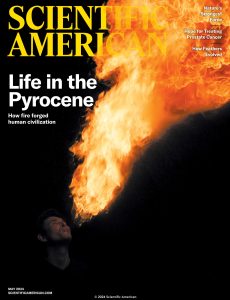
Scientific American Magazine May 2024
English | 96 pages | pdf | 16.3 MB
HAVE YOU EVER picked up a feather and felt how smooth, sleek, firm or fluffy it is? (The Migratory Bird Treaty Act prohibits possession of most bird feathers, but if you find a feather and stick it in your cap or pack,
nobody here at Scientific American will turn you in.)
Feathers are marvels of evolutionary engineering that have been studied for centuries, but in the past few years, as paleontologist Michael B. Habib details on page 40, scientists have made somebig discoveries about their evolution, structure and function. We hope the story will help you appreciate the specializations of hummingbirds, hawks, penguins, owls, and more.
The “strong force” that pulls together protons, neutrons and atomic nuclei is, as its name suggests, the strongest force we know of in the universe. It’s also the least understood. But recently physicists have made real progress in measuring the strong force.
Among other things, they’ve discovered that it becomes constant at a certain distance between particles. Stanley J. Brodsky, Alexandre Deur and Craig D. Roberts recount on page 32 how their independent lines of research merged to uncover new properties of the force that binds together most of the matter in the universe. Children want to be fair, and they acquire a sense of justice at a very young age: they quickly learn that hurting other people is wrong and that sharing is right. But this developing sense of morality can conflict with their developing sense of belonging. Children readily pick up on us-versus-them group identities based on factors such as race and gender. On page 52, psychologist Melanie Killen describes what she and her colleagues have learned about morality and prejudice in children. Based on their research they created a training program that successfully teaches kids to be more inclusive and empathetic.
We are living in the age of fire—the Pyrocene, a term coined by environmental historian Stephen Pyne. As he writes on page 22, humans tamed fire and changed the world. He breaks our relationship with fire into three waves and chronicles how fire has changed human bodies and civilization and is now changing all life on the planet. Enjoy the dramatic, fire-breathing photo-essay by Kevin Cooley that accompanies the article.
Prostate cancer is one of the most common types of malignancies, but thanks to advances in detection, evaluation and treatment, it has become increasingly manageable. On page 66, Marc B. Garnick, a leading expert on prostate cancer, explains how the disease starts and grows. He also provides an overview of the methods that can now be used to monitor and stop it, adding years to patients’ lives.
Some of the first images captured by the James Webb Space Telescope a few years ago were shocking: they revealed overgrown galaxies in the early universe—galaxies that, according to cosmological theory, shouldn’t have existed. As science writer Jonathan O’Callaghan shows on page 70, astronomers are coming up with new theories to explain these unexpected galaxies and im prove our understanding of their formation.
One of the things I appreciate most about walks in nature (the kinds of walks where you might find a feather and where the loudest sound is a screaming cicada) is how peaceful they are. If you’ve ever tensed up in irritation at leaf blowers, shouty bars, obnoxious car horns, or other noise pollution, health correspondent Joanne Silberner’s story on page 58 may feel like vindication. A growing body of research documents how and why noise can cause a range of health problems and how you can reduce your exposure to improve your health. And our Science of Health columnist Lydia Denworth explores the importance of nature and well-being ( page 76 ). May you be surrounded by pleasant and welcome sounds as you delve into this month’s issue.
Laura Helmuth is editor in chief of Scientific American Magazine
Download from: